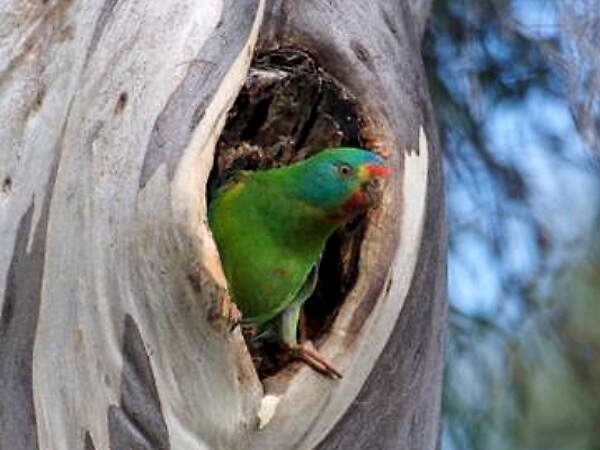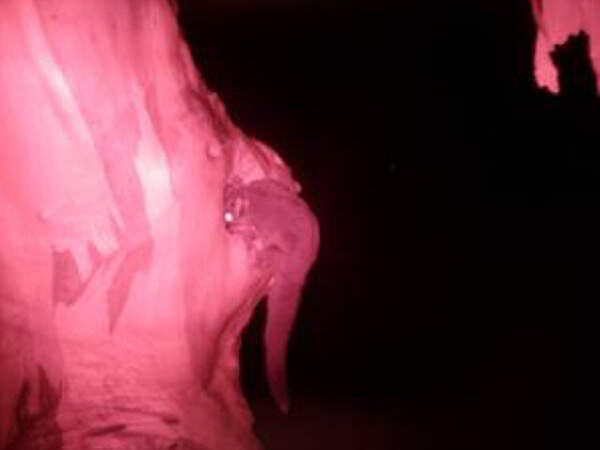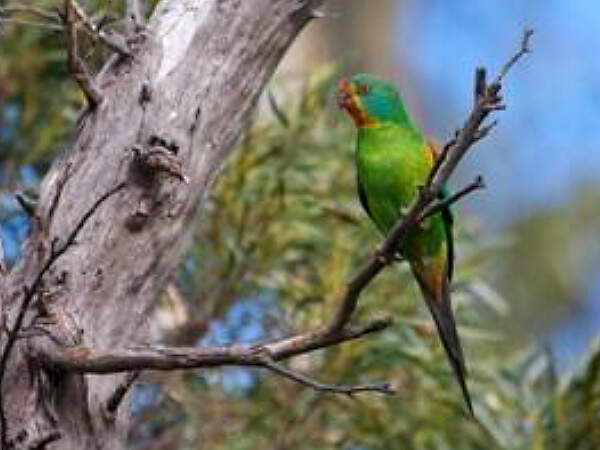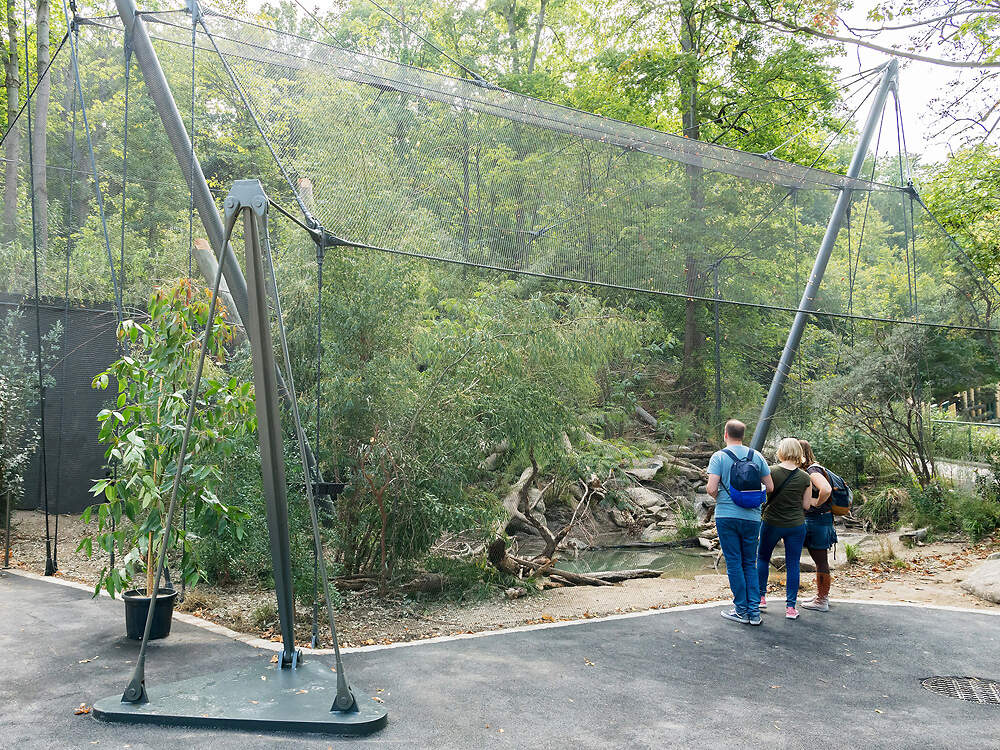HEINSOHN, R., WEBB, M., LACY, R., TERAUDS, A., ALDERMAN, R. & STOJANOVIC, D. (2015)
A severe predator-induced population decline predicted for endangered, migratory swift parrots (Lathamus discolor).
Biological Conservation 186 (Juni 2015): 75–82.
doi:10.1016/j.biocon.2015.03.006; http://www.sciencedirect.com/science/article/pii/S000632071500110X
Abstract:
Identifying the impact of introduced predators on endangered prey populations is critical for conservation management. Population viability analysis (PVA) becomes a valuable tool for quantifying such impacts when high quality life history data are available but, surprisingly, predictions from PVA of future population decline have seldom been used directly to assess conservation status. Here we synthesise new research on the unusual life history of the endangered swift parrot Lathamus discolor, an austral migrant that breeds in Tasmania, Australia. Swift parrots are challenging to monitor because (1) spatio-temporal fluctuation in food availability causes them to select entirely different breeding sites each year over a 10,000 km2 range, and (2) they suffer high but variable rates of predation from introduced sugar gliders Petaurus breviceps depending on where they breed. 50.9% of nesting females on the main island of Tasmania were killed by sugar gliders while incubating eggs, but there was no predation from this source on offshore islands. Over four years 16.5% (0–29%) of the population bred on offshore islands. We use PVAs to examine the likely extent of future population decrease due to sugar glider predation, and demonstrate that the remaining swift parrot population is likely to decrease by 78.8–94.7% (mean over four models = 86.9%) over only three generations (12–18 years). Our models offer a rare example of the use of PVAs for assessing impending population decline and conservation status in species that are challenging to monitor. In this case they support a change of status for swift parrots from “Endangered” to ‘Critically Endangered’ under IUCN criteria.
heinsohn-biblio
Projekte Schwalbensittich
In situ- und Ex situ- Projekte zur Erhaltung des Schwalbensittichs
|
|
Erforschung der Brutbiologie und des Wanderverhaltens des SchwalbensittichsDer Schwalbensittich (Lathamus discolor) gilt als stark gefährdet, weil sein Bestand nur noch etwa 2'000 erwachsene Vögel umfasst und weiter abnimmt. Hauptsächlicher Grund für den Niedergang der Art ist die zunehmende Zerstörung der für sie unverzichtbaren, von Blauem Eukalyptus (Eucalyptus globulus) dominierten Trockenwälder und insbesondere das Fällen alter, als Nistbäume geeigneter Bäume. Als Grundlage für einen effektiven Schutz des Schwalbensittichs erforscht die Fenner School of Environment and Society der Nationalen Universität Australiens die Brutbiologie und das Wanderverhaltens des Schwalbensittichs. Dabei wird u.a. abgeklärt, welches Auswirkungen die Art der Landnutzung auf die Vögel hat und welche Anforderungen hinsichtlich Nahrungsquellen und Nisthöhlen für eine erfolgreiche Fortpflanzung erfüllt sein müssen. Bisherige Ergebnisse zeigen, dass die Schwalbensittiche zum Nisten alte Bäume mit überdurchschnittlich vielen Höhlen bevorzugen, dass sie unter bestimmten Umständen von Blauen Eukalypten auf Schwarze Eukalypten (Eucalyptus ovata) als Nahrungsquelle ausweichen, dass der Nachzuchterfolg massiv dadurch beeinträchtigt werden kann, und dass viele Nester durch die auf Tasmanien angesiedelten Kurzkopfgleitbeutler (Petaurus breviceps) ausgenommen werden, was durch Fotofallen belegt werden konnte. Ferner wurden zur Bestimmung der Wanderbewegungen verschiedene Sendegeräte getestet. Der Loro Park auf Teneriffa unterstützt durch seine Loro Parque Fundación dieses langfristige Forschungsprojekt. Bis 2015 wurden 147'705 US$ dafür aufgewendet. Ex situ-ZuchtIm Hinblick auf den Aufbau eines Erhaltungszuchtprogramms erstellte der Tiergarten Schönbrunn mit einem Kostenaufwand von 500'000 € eine Voliere für eine Zuchtgruppe dieser Vögel, die bei der Eröffnung 2019 mit 24 Sittichen besetzt wurde. Mit einer Grundfläche von 140 Quadratmetern und einer Höhe von bis zu sieben Metern bietet sie den Sittichen viel Raum zum Fliegen. Ein Teich mit Wasserlauf lädt zum Baden ein und ist auch für ihre Mitbewohner, die Mähnengänse, gedacht. Siehe auch Zuchtprojekt der "Gesellschaft für arterhaltende Vogelzucht“ (GAV). Tierart-Datenblatt: Schwalbensittich (Lathamus discolor)Lebensraum: Trockenwälder der gemäßigten Zone Australiens |
Literatur und Internetquellen:
- BIRDLIFE INTERNATIONAL (2018). Lathamus discolor. The IUCN Red List of Threatened Species 2018: e.T22685219A130886700. http://dx.doi.org/10.2305/IUCN.UK.2018-2.RLTS.T22685219A130886700.en . Downloaded on 27 August 2019.
- HEINSOHN, R., WEBB, M., LACY, R., TERAUDS, A., ALDERMAN, R. & STOJANOVIC, D. (2015)
- Loro Parque Fundación (2015) Research and Conservation Report 2013/2014. Puerto de la Cruz, Tenerife. 55 Seiten.
Zurück zu Schwalbensittich (Lathamus discolor)
Weiter zu Wellensittich (Melopsittacus undulatus)
WAYNE, A.F., MAXWELL, M.A., WARDA, C.G., VELLIOSA, C.V., WILSON, I., WAYNE, J.C. & WILLIAMS, M.R.(2015)
Sudden and rapid decline of the abundant marsupial Bettongia penicillata in Australia.
Oryx 49 (1) / January 2015: 175-185. Fauna & Flora International
DOI: http://dx.doi.org/10.1017/S0030605313000677 Published online: 29 November 2013
Abstract:
The woylie Bettongia penicillata is categorized as Critically Endangered, having declined by c. 90% between 1999 and 2006. The decline continues and the cause is not fully understood. Within a decline diagnosis framework we characterized the nature of the decline and identified potential causes, with a focus on the species’ largest populations, located in south-west Western Australia. We described the spatio-temporal pattern of the decline, and several attributes that are common across sites. We categorized the potential causes of the decline as resources, predators, disease and direct human interference. Based on the available evidence the leading hypothesis is that disease may be making woylies more vulnerable to predation but this remains to be tested. No substantial recoveries have been sustained to date, and one of the three remaining indigenous populations now appears to be extinct. Therefore, verifying the factors causing the decline and those limiting recovery is becoming increasingly urgent. Active adaptive management can be used to test putative agents, such as introduced predators. Insurance populations and ecological monitoring should also be included in an integrated conservation and management strategy for the species.
wayne-biblio
JONES, R. (2008)
Husbandry Guidelines for the Common Hippopotamus.
Western Sydney Institute of TAFE, Richmond, NSW, Australien.
105 Seiten. Fotos, Grafiken, Tabellen
PDF herunterladen von http://nswfmpa.org/Husbandry%20Manuals/Published%20Manuals/Mammalia/Common%20Hippopotamus.pdf
jones-biblio
SPENCER, B. (ed., 1896)
Report on the Work of the Horn Expedition to Central Australia.
Dulau and Co: London; and Melville, Mullen & Slade: Melbourne.
4 Bände, mit Bildtafeln
Downloads: https://archive.org/details/reportonworkhor02horngoog
Summary:
The purpose of this scientific expedition, sponsored by mining magnate and philanthropist William Austin Horn, and with Charles Winnecke as commander and surveyor, was to examine the MacDonnell Ranges on the not unreasonable premise that 'when the rest of the Continent was submerged the elevated portions of the McDonnell [sic] Range existed as an island, and that consequently older forms of life might be found in the more inaccessible parts'. This in fact proved not to be the case, but the expedition (of some fourteen weeks and 2000 camel miles undertaken between May and August 1894) was an outstanding success. 'It was not the intention ... to explore a new region ... But in the pursuit of natural history the expedition split into independent groups and explored undiscovered areas, thus filling in more of the blank spaces in this vast region' (Feeken, Feeken and Spate). 'These volumes constitute one of the most substantial contributions in nineteenth-century Australian exploration [but perhaps more importantly, the expedition is] a landmark in anthropological history because it resulted in [Baldwin] Spencer meeting Frank Gillen' (Mulvaney).
Contents:
pt. 1. Introduction, narrative, summary of results, supplement to zoological report, map / W. A. Horn ... [et al.].
pt. 2. Zoology / Baldwin Spencer ... [et al.].
pt. 3. Geology and botany / Ralph Tate and J. A. Watt.
pt. 4. Anthropology / E. C. Stirling.
spencer-biblio
SLATER, P. (1972)
A Field Guide to Australian Birds.
Vol. 1: Non-Passerines.
428 Seiten, davon 64 Farbtafeln, einige s/w-Abbilungen, Verbreitugskarten.
Oliver & Boyd, Edinburgh. ISBN 0-05-002357-8.
Review by Arnold McGill:
Except for Cayley’s What Bird is That? there has been no readily available publication in which all Australian species are illustrated. Mr P. Slater is now filling a great need. The first part of his work is available and the second will, it is understood, soon be completed. A Field Guide to Australian Birds has a much wider scope than Cayley’s book. Apart from the continent and Tasmania it covers the political dependencies Norfolk, Lord Howe, Macquarie, Heard, Christmas and Cocos-Keeling Islands. This is commendable; for, often these outposts of the Commonwealth have been sadly neglected ornithologically and for the first time a fully illustrated guide is available, reasonably priced, covering the whole area except the New Guinea region. It is therefore interesting to see included in an Australian book such species as the Ruddy Crake (Christmas Island), Woodhen (Lord Howe), Weka (Macquarie) and even a new family (Sheathbills), which occurs on Heard Island.
The illustrations throughout are ample and appear well-executed. Of special significance are the outlines of bills of the Procellariiformes, drawn to actual size, thus providing for a direct check with any specimen examined in the hand or found as a beach derelict. Patterns of flight, especially of seabirds, hawks, terns and waders, are also depicted carefully. Allowing for difficulties in reproducing exact colour, the appearance and shades of species are most pleasing. The size of bill of the Red-necked Stint (p.279) is far too long, but care in such matters is widely apparent. Because there might be some confusion in identifying swallows and swifts, the former family has been added after the Coraciidae. The second part of this publication will be as eagerly awaited as was the first. The whole will be a notable contribution to the ornithology of Australia and a very helpful guide to every field-worker.
slater-biblio
WEBB, G. & MANOLIS, C. (1989)
Crocodiles of Australia.
112 Seiten, farbig illustriert. Reed Books Pty. Ltd.; ISBN 6-7301-0254-8
Verlagstext:
Crocodiles are abundant in most rivers, creeks and swamps in northern Australia and are a major tourist attraction. They are part of the great 'northern adventure' that domestic and international visitors travel so far to experience. In Australian Crocodiles - A Natural History, Grahame Webb and Charlie Manolis uncover the 'private lives' of crocodiles, with comprehensive studies on reproduction, growth, movement, behaviour, habitats and food. The book begins by tackling the history of crocodile hunting and the rising demand for crocodile skins for use in fashion items, to their eventual protection and farming not just in Australia but around the world.The authors explore the anatomy, physiology and embryology of these fascinating animals. They also examine attacks on humans, the history of crocodile hunting and farming, surveying, catching and handling.Includes bibliographical references and index.
REINER, E. & LÖFFLER, E. (Hrsg. 1977)
Australien.
224 Seiten mit einigen Karten und 138 teils ganzseitigen farbigen Fotos auf Kunstdrucktafeln, farbige Karte auf den Vorsätzen.
Kümmerly & Frey, Geographischer Verlag, Bern. ISBN 3-259-08471-1.
KEAST, A. (1967)
Knaurs Kontinente in Farben - Australien und Ozeanien.
304 Seiten, mit 106 Farb-, und 133 s/w-Fotos sowie 14 Karten.
Droemersche Verlagsanstalt Th. Knaur Nachf., München und Zürich.
Inhalt:
Australien Die Inseln Ozeaniens Neuguinea Neuseeland.
GÜNTHER, J. & MOHR, J. (2011)
australienweit – Naturzeit Australien.
544 Seiten, 598 Farb- und 34 s/w-Fotos, 209 Grafiken, 83 Karten
2. Aufl., Verlag 360º, D-23970 Gamehl. ISBN 978-3-9809763-5-0.
Verlagstext:
australienweit ist die einzige Reiseführerreihe, die auf den 5. Kontinent spezialisiert ist. Seit über zehn Jahren erfolgreich auf dem Markt, sind die Bände dieser Reihe unter Australienfreunden zu einem echten Begriff geworden.
Der vierte Band widmet sich in gewohnter Qualität der einzigartigen Natur des Kontinents. Neben einer ausführlichen praktischen Einleitung, hilfreichem Kartenmaterial und einstimmenden Fotos enthält dieser Reiseführer:
Eine vielseitige Einführung in die Flora, Fauna und Geologie des Kontinents sowie Interessantes über ein Gift namens »1080«, das Vermächtnis der Vulkane, den südlichen Sternhimmel, nützliche Buschfeuer und vieles mehr.
Die detailfreudige Beschreibung von 101 sehenswerten Nationalparks. Informationen über Flora und Fauna gehören ebenso dazu wie eine wertvolle Übersicht über die bestehenden Wander- und Campmöglichkeiten. Umfassende Informationen über die einzigartige Flora und Fauna inklusive eines 110 seitenstarken Bestimmungsteils, in dem die wichtigsten und ungewöhnlichsten Tiere und Pflanzen vorgestellt werden. Wissenswertes über die geologische Entstehungsgeschichte des Kontinents und seine landschaftlichen Charakterzüge einfach erklärt und anhand anschaulicher Grafiken verdeutlicht.
günther-biblio




